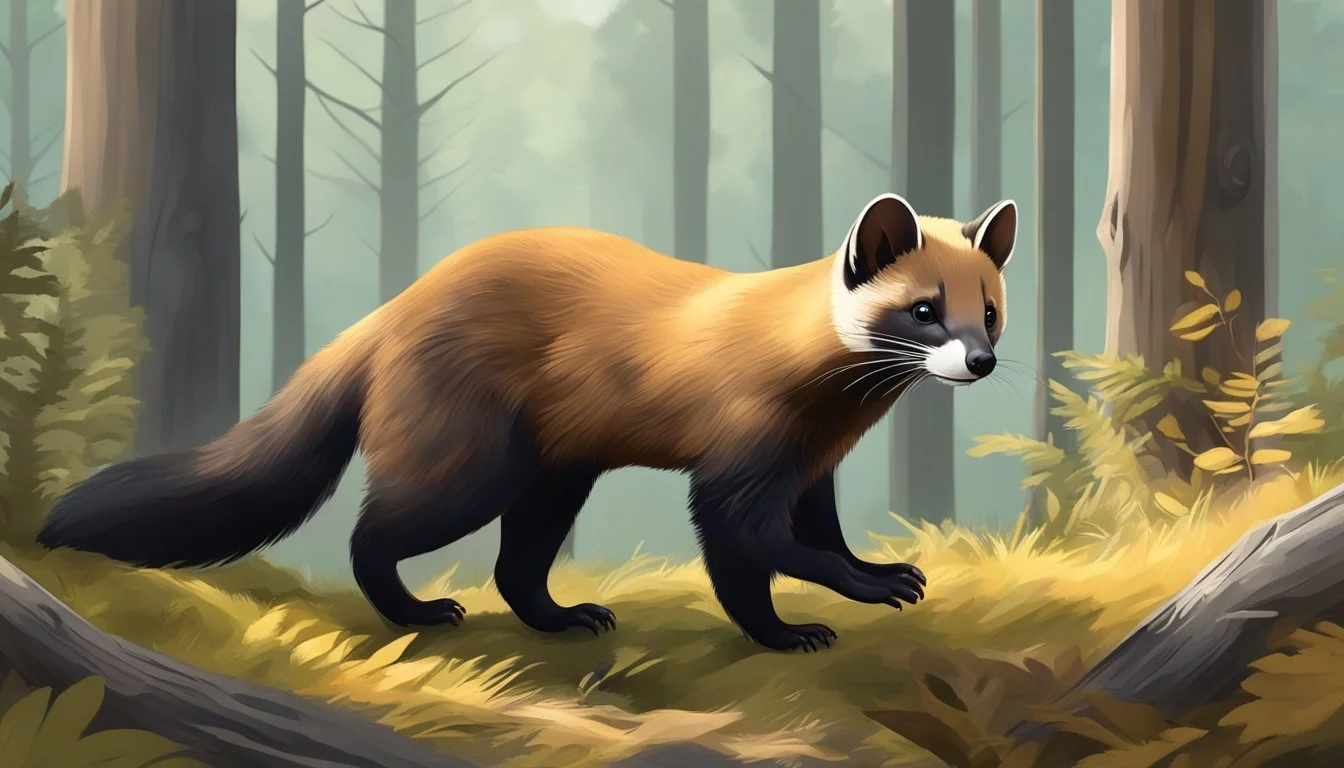Marten Hunting Seasons
Regulations and Timelines Across Regions
This Article is Part of Our Guide on Hunting Seasons for Over 70 Common Game Species
Marten hunting seasons are structured to maintain a balance between conservation and outdoor sporting activities. These small, agile members of the weasel family, which include species like the American marten, are sought after for their fur and are a part of wildlife ecosystems across various regions, including parts of North America. The establishment of hunting seasons is critical to ensure their populations remain sustainable amidst other natural challenges they face, such as disease and environmental pressures.
In some states, such as Minnesota and Montana, marten populations have rebounded enough to allow for regulated hunting and trapping seasons. Thanks to careful wildlife management, these states have been able to establish specific seasons when hunters and trappers can harvest martens under controlled limits. Regulations typically specify bag limits, permissible methods of capture, and designated areas where hunting or trapping can occur, all aimed at preserving the species while still providing opportunities for outdoor enthusiasts.
Marten Biology
Marten species, including the pine marten and the fisher, are recognized for their distinctive physical attributes and their diverse foraging habits. They play an important role in forest ecosystems as both predator and prey.
Physical Characteristics
Martens are slender, agile animals with elongated bodies and bushy tails. Two commonly known species are:
Pine Marten (Martes martes):
Body Length: 45-58 cm
Tail Length: 18-25 cm
Weight: 0.9-1.5 kg
Fisher (Martes pennanti):
Body Length: 50-65 cm
Tail Length: 30-42 cm
Weight: 2-7 kg
Their fur ranges from light to dark brown, and they often have a recognizable cream or yellow throat patch.
Diet and Foraging Behavior
The diet of martens is extensive and includes a variety of:
Prey:
Small mammals (voles, mice)
Birds
Insects
Fish
They also consume berries and other fruits, particularly when other food sources are scarce. Hunting and foraging behavior is characterized by agility and opportunism, adapting to the availability of prey in their forested habitats. Martens are primarily nocturnal, using their keen sense of sight and smell to locate prey.
Habitat and Distribution
Marten populations are closely associated with specific habitats that support their survival and reproductive needs. This section explores the inherent characteristics of these habitats as well as where martens are geographically spread.
Natural Habitat
Martens are arboreal creatures that thrive in mature woodlands. Their preferred habitats are predominantly coniferous forests, although they can also be found in mixed woodlands with both coniferous and deciduous trees. These forests offer abundant prey, vertical escape routes from predators, and ample denning opportunities. The complexity of mature forests, including features like snags and downed wood, are critical for their hunting and denning behavior.
Geographical Range
The geographical range of martens covers extensive northern regions. In North America, they occupy a broad expanse from Alaska and across Canada, encompassing provinces like Newfoundland and Nova Scotia. In the United States, martens are located primarily in the northern states such as Maine, New York, New Hampshire, Vermont, and extending slightly into the elevated regions of West Virginia and Virginia. These animals are integral to the ecosystems they inhabit, influencing both prey populations and the ecological dynamics of these forested areas. Their presence across various regions underscores their adaptability to different forest types within their range.
Reproductive Behavior
Understanding the reproductive behavior of martens is crucial for managing their populations and setting appropriate hunting seasons. This entails examining their breeding patterns and the subsequent development of their offspring.
Breeding Patterns
Martens typically have one breeding season per year, during which they engage in mating rituals that include vocalizations and scent marking. A key feature of their reproduction is delayed implantation; fertilized eggs remain dormant for several months before implanting in the uterus and resuming development. This adaptation allows births to coincide with favorable environmental conditions. The gestation period is around 27 weeks, but the actual embryonic development only takes a short span of roughly 30 days due to delayed implantation.
Offspring and Development
Upon birth, marten kits are blind and dependent on the mother. Litters commonly consist of 1 to 5 offspring, with each kit weighing about 30 grams. The first few weeks of life are spent in the safety of a den, which can be a hollow tree or a burrow repurposed from other animals.
Development milestones for kits include:
Opening their eyes at 39 days
Weaning off at 42 days
Exploring outside the den at 50 days
The mother teaches the kits survival skills until the end of summer when they reach independence. This is followed by dispersal, where the young marten leave their mother's territory to establish their own. Survival rates can be influenced by various factors, including the availability of prey and habitable denning sites.
Conservation and Management
In ensuring the viability of marten populations, conservation and management strategies play a crucial role. These measures are targeted at mitigating factors such as habitat loss and unregulated harvest, which have historically impacted marten species.
Population Studies
Research on marten demographics is foundational to conservation efforts. Population studies involve monitoring trends in marten numbers and distribution. Vital statistics such as birth rates, survival rates, and cause-specific mortality rates provide insights that guide management actions. For example, American Marten (Martes americana) has been extensively studied to understand its role as a Management Indicator Species in various US national forests.
Key Areas of Study:
Habitat Use: Examining how martens utilize different forest types for activities such as foraging and denning.
Home Range Size: Determining the size of territories, which can average between 0.6-2.2 square miles.
Population Density: Estimating the number of individuals within a specified area.
These studies ideally inform the public and regulatory bodies about necessary interventions.
Conservation Efforts
Conservation efforts for martens are multifaceted, addressing threats such as deforestation, disease, parasites, and unregulated trapping. Agencies implement best management practices to reduce these threats, often leading to the creation of strategic trapping regulations and the establishment of protected areas where hunting is either limited or prohibited.
Specific Strategies:
Habitat Protection: Safeguarding and managing forests to prevent fragmentation and loss, ensuring marten-friendly environments.
Regulated Harvest: Establishing and enforcing hunting seasons and zones to prevent overharvesting.
Reintroduction: In some regions, reintroducing martens to areas where populations have declined is crucial for species recovery.
Public engagement and education are also critical for the success of these conservation initiatives, as they promote understanding and support for marten protection measures.
Marten Hunting Regulations
In the pursuit of maintaining a balance between wildlife conservation and the interests of fur harvesters, regulations for marten hunting are established. These regulations encompass specific trapping seasons and legal frameworks to ensure sustainable harvesting practices.
Trapping Seasons
The specific time during which martens can be trapped varies by location. For instance, Michigan's Upper Peninsula (UP) typically allows marten trapping during set seasons, which are determined by the state's wildlife management authority. Trapping seasons might also exist in other states where the American marten population is sustainable and monitored. Hunters typically require special tags or permits for trapping martens, reinforcing the regulated nature of the activity.
Michigan:
Trapping Season: Dates designated by wildlife management authorities.
Tags Required: Yes, for specific species including martens.
Minnesota:
Had historical periods where trapping was reopened due to sufficient population recovery.
Legal Framework
The legal framework governing marten hunting is multifaceted. Hunters must obtain the necessary licenses and follow state-specific guidelines that may include:
Base License: Mandatory for fur harvesting in some states, like Michigan.
Fur Harvesting License: Required to trap species such as martens.
Kill Tags: In some regions, free kill tags are issued and must be used for species like the marten.
Regulations often require hunters to submit harvest reports to track population numbers and ensure the species is not overharvested. This data helps in adjusting seasons and bag limits to protect the marten population.
Note: Regulations and requirements may change; always check with local wildlife authorities for the most current information.
Behavioral Ecology
The behavioral ecology of martens revolves around their adaptive strategies for hunting and survival within their respective habitats. These medium-sized carnivores exhibit complex behaviors that ensure their survival and reproductive success.
Predatory Habits
Martens are proficient predators with a varied diet, primarily comprising rodents such as bank voles, which constitute a significant part of their food intake. Their foraging behaviors are influenced by the landscape they inhabit, where anthropogenic changes can alter the distribution and availability of prey. Martens use a combination of stealth and agility to hunt, often exploiting the cover provided by dense vegetation or snow. In snowy regions, martens have been observed to use subnivean access sites to hunt for prey that takes refuge underneath the snow layer.
Key Prey: Rodents (e.g., bank voles)
Hunting Methods: Stealth, use of cover, subnivean access
Survival Strategies
For martens, survival strategies involve both territoriality and intelligent use of their habitat. They are known to be solitary creatures with well-defined home ranges where they perform most of their life activities including foraging and mating. Martens demonstrate adaptability, modifying their resource selection seasonally to increase their survival chances. Additionally, they rest in secure locations that provide protection from predators and harsh weather conditions. This territorial behavior is essential for martens as it helps in maintaining adequate food supply and offering safety from competitors while promoting genetic diversity through mate selection within these territories.
Home Range: Defined areas for foraging and mating
Adaptability: Seasonal resource selection
Resting Sites: Secure places for protection
Martens balance their need for food with the imperatives of survival and reproduction through a remarkable set of behaviors intrinsic to their ecological niche. Their ability to adapt to changing conditions is a crucial aspect of their behavioral ecology.
Marten Interaction with Other Species
Martens, a member of the Mustelidae family, notably interact with various species, either as competitors or through symbiotic relationships that influence their survival and behavior in their habitats.
Competitors and Threats
Martens face competition for food and habitat from other mid-sized carnivores. Fishers, their close relatives, are one such competitor. Both martens and fishers do not actively segregate in space and time during peak hours of foraging, indicating direct competition for resources that are abundant in overlapping territories. Large birds of prey, such as owls and eagles, also pose a threat, preying on martens, especially the young or infirm.
Predation pressure from other mammals like coyotes and red foxes adds to the challenges martens face in their environment. These predators often compete for similar food sources, including rodents, small mammals, and occasionally birds.
Symbiotic Relationships
The small size of martens allows them to play a unique role in their ecosystem. They prey on a variety of smaller species such as rodents, which can contribute to controlling these populations. Their diet also includes insects, reptiles, amphibians, and bird eggs, which demonstrates their position as an integral part of the food web, impacting the abundance and behavior of these species indirectly through predation.
Despite the competitive nature of their interactions with some species, martens also inadvertently aid other animals of prey by impacting the availability of shared food sources. This dynamic showcases the complexity of symbiotic relationships martens have within their ecosystem.
Physical Adaptations
American martens are agile tree climbers with distinct physical adaptations that enhance their hunting efficiency throughout the seasons.
Climbing and Sheltering
American martens possess strong muscles in their legs and feet, granting them exceptional climbing capabilities to pursue prey and evade predators. These adaptations are crucial as they spend considerable time in trees and often rely on snags—standing dead trees—and hollow logs for shelter. Their sharp claws enable them to grip the bark firmly, making them adept tree climbers. Furthermore, American martens use cavities in trees not only for resting but also for protection from harsh weather conditions and as strategic points for hunting.
Seasonal Adaptations
In response to the changing seasons, martens exhibit remarkable seasonal adaptations. During winter, their fur thickens to provide insulation against the cold. The marten's capacity to create and use subnivean spaces—areas underneath the snow—allows them to conserve heat and access food sources during the winter months. Conversely, in summer, their coat becomes lighter, which helps to prevent overheating. These seasonal changes in fur are complemented by a diet that varies based on availability, relying on plant materials in some seasons while focusing on animal prey in others. Their physical adaptations ensure they are well-equipped for the diverse demands of each season, reflecting a resilience that is critical for survival in their variable habitats.
Human Interactions
Martens are affected by human activities, primarily through hunting and trapping, altering their interactions with humans and ecosystems. These activities serve both as a management tool and a challenge to marten populations.
Hunting and Trapping Impact
Martens are hunted and trapped for their fur. This practice has historically led to a significant decline in marten populations. Regions with active marten hunting seasons are subject to regulations which can include:
Season Dates: Specific times of the year when hunting or trapping is permitted.
Bag Limits: A cap on the number of animals that can be harvested by an individual.
Trapping Methods: Regulations that dictate the types of traps and methods of trapping allowed.
Hunting and trapping regulations are crafted with the intention of managing marten populations sustainably. However, in areas with unregulated harvest, overexploitation can occur, threatening local marten populations.
Encounters and Safety
Human interactions with martens are rare due to the animal’s typically elusive nature. When encounters occur, they are usually incidental and not aggressive. Yet, it is vital for the public to maintain a safe distance to prevent potential stress or harm to the animals. Some safety guidelines include:
Avoid Feeding: Feeding martens can lead to unnatural behavior and increased contact with humans.
Secure Campsites and Residences: To prevent unintentional exposure to martens, food and waste should be securely stored.
Exposure to humans can affect marten behavior and habitat use, therefore, it is important for humans to minimize their impact and exposure, ensuring coexistence and the safety of both parties.








